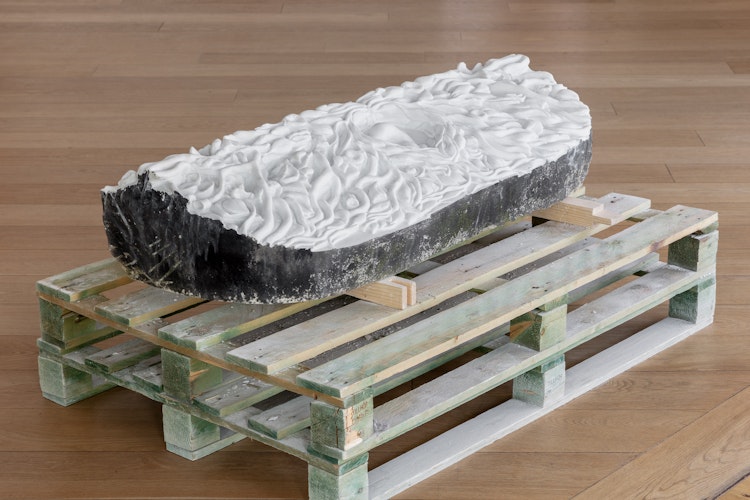Utvalgte Verk: Oktober


This month, we are focusing on artists who use stone and minerals as creative tools. The use of stone in art dates back thousands of years and has deep roots in culture and symbolism. Stone has been used for art for many millennia, resulting in sculptures and beautiful artworks that have endured for centuries.
Today, stone remains a highly fascinating artistic medium. Its solidity and durability contrast with the constantly changing digital world we live in. At the same time, contemporary artists challenge the traditional perception of stone by exploring the boundaries of what is possible with this material. The timeless nature of stone and its ability to express concepts make it an exciting resource for today's artists.
We would like to introduce four artists who explore various forms of rocks in their artistic work: Aksel Ree, Sverre Gullesen, Kaja Dahl, and Marianne Heske.
Aksel Ree (born 1993, Hamar) holds a degree in interior architecture from KHIO.
The fragmented body is a prominent motif in several of Ree's marble reliefs. These fragments explore the material's ability to approximate a sense of skin. In Ree's marble reliefs, the most vulnerable and intimate parts of the body are depicted, oscillating between the classical and the contemporary. With detailed ornaments, the works teeter on the edge of kitsch and banality while simultaneously drawing connections to art history and the narrative of the androgynous.
In his latest series, "198C," Ree reflects on Plato's Symposium and the myth of the division of humans into two. The classical text recounts that humans' earliest form was circular and divided into three genders: the masculine from the sun, the feminine from the earth, and the androgynous from the moon. These beings stood in opposition to the gods, and it was decided that humans should be split in two, leaving the navel as a sign of this division. The navel emerges in Aksel Ree's body of work as the most intimate part of the body, the core of tenderness, and the idea of our previous form.
Working with marble, Ree describes as the most intimate artistic process he knows, as it demands his entire body and mind. During his work, he no longer distinguishes between the material and his own skin. In a way, he feels like he is always working in marble, even when working with other materials.
Sverre Gullesen (born 1980, Mo i Rana, Norway) is educated at the Ecole Nationale Superieure des Arts Visuels de la Cambre in Brussels and the Oslo Academy of the Arts.
He has previously worked with performance and "social choreography." From 2006 to 2015, he was part of the infamous artist group D.O.R (Deadly Orgone Radiation). In recent years, Gullesen has focused on material-based art and has gained significant attention for his sculptures and sculptural wall works that question both societal and historical perceptions. His sculptures can be reminiscent of grand modernist facades. Simultaneously, they express their unique visual language and fragility that contrasts with the idea of masculine modernism. Unlike the brutality of modernism, Gullesen's sculptures can be seen as organic and expressive, varying in size, shape, color, and material usage. His works are both humorous and commanding, playing with ideas surrounding societal structures, systems, and ideologies that are deconstructed and reworked.
Kaja Dahl, born in 1984 in Oslo, holds a master's degree in Design for Luxury and Craftsmanship from ECAL in Switzerland and a bachelor's degree in Product and Interior Design from Beckmans College of Design in Stockholm. Dahl's works are part of various private and public collections, including the National Museum.
She works with different materials like raw stone, terracotta, glass, and porcelain, creating sculptures that aim to enhance the sensory connection between humans and the natural materials around them. Using techniques that blend craftsmanship and product design, Dahl crafts unique and tactile pieces with a distinctive aesthetic sensibility. Since 2019, Dahl has been based in Oslo after several years of design-related projects and residencies abroad.
Marianne Heske, born in 1946, received her education from Bergen Kunsthåndverkskole, Ecole Nationale Supèrieure des Beaux Arts in Paris, Royal College of Art in London, and Jan van Eyck Academie in Maastricht. Heske has been an active artist for over 40 years and has exhibited in museums worldwide. Her works are part of major museums in Norway as well as several international ones, including the Centre Georges Pompidou in Paris.
Central to Marianne Heske's artistic career are the sculptures she creates using doll heads. This is a lifelong project based on an antique 19th-century doll head she found at a market in Paris in 1971.
These doll heads have been a constant presence in Heske's art, representing cultures from around the world. They are made from various materials, including hardwood from Kenya, gemstones from Zimbabwe, porcelain from China, full-lead crystal from Norway, metal heads plated with gold, silver, and copper from Nepal, doll heads made from beads and recycled cans from Zimbabwe, and marble from Agra, India. Heske spends a long time getting to know the places where the heads are produced and the unique cultures associated with them. The original doll head from Paris serves as a reference for local craftsmen, who are asked to create their own interpretations.
These heads represent the uniqueness of each person and can be viewed individually or in groups, symbolizing the relationships between human beings.
In Torshovdalen, Oslo, there is a 10-ton bronze sculpture of a doll's head based on a figure Heske discovered in 1971, made of papier-mâché, at a market in Paris.
What are you looking for?